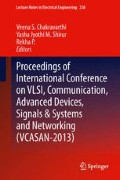Abstract
The performance of submicron MOSFET with a thin conventional SiO2 gate dielectric degrades due to increasing gate leakage currents. High-k dielectric materials are used as alternate gate dielectric to overcome the problem. The introduction of high-k dielectric induces high interface charges which degrades both the mobility and threshold voltage of MOS device. Simulation of devices with suitable tools and models helps us to mimic the device performance. Often errors are possible during selecting the models and regions of probing during simulation of results. This paper investigates the role of interface charges on carrier mobility and other MOSFET parameters. The probing positions for extraction of mobility are optimized by simulating the mobility at various positions along the channel and at various depths in the channel. From simulation results, it is shown that higher mobility is obtained by probing in the middle of the channel, 1 nm below the HfO2–Si interface. The performance of the high-k MOSFET with metal electrode and polysilicon electrode is also compared for various interface state charges.
Access this chapter
Tax calculation will be finalised at checkout
Purchases are for personal use only
References
Fishetti M (2003) Scaling MOSFETs to the limit: a physicist’s perspective. J Comput Electron 2:73–79
Wilk GD, Wallace RM, Anthony JM (2001) High-κ dielectrics: current status and material considerations. J Appl Phys 89(10):5243–5275
Jeong DS, Hwang CS (2005) Tunneling-assisted Poole-Frenkel conduction mechanism in HfO2 thin films. J Appl Phys 98(1137):113701
DiStefano TH, Shatzkes M (1974) Impact ionization model for dielectric instability and breakdown. Appl Phys Lett 25(12):685–687
Chen IC, Holland S, Hu C (1985) Electrical breakdown of thin gate and tunneling oxides. IEEE Trans Electron Dev ED-32:413
Gusev EP, Cartier E, Buchanan DA, Gribelyuk M, Copel M, Okorn-Schmidt H (2001) Ultrathin high-k metal gate oxide on silicon: processing, characterization and integration issues. Microelecton Engg 59:341–349
Zhu WJ, Ma TP, Zafar S, Tamagawa T (2002) Charge trapping in ultrathin hafnium oxide. IEEE Electron Dev Lett 23:597–599
Nahar RK, Singh V, Sharma A (2007) Study of electrical and microstructure properties of high dielectric hafnium oxide thin film for MOS devices. J Mat Sci Mater Electron 18:615–619
Fischetti M, Neumayer D, Carttier E (2001) Effective electron mobility in Si inversion layers in MOS systems with a high-k insulator: the role of remote phonon scattering. J Appl Phys 90:4587–4608
Kotlyar R, Giles MD, Matagne P (2004) Inversion mobility and gate leakage in high-k/metal gate MOSFETs. Electron Devices Meeting, 2004. IEDM Technical Digest. IEEE International, pp 391–394
Weber O, Andrieu F, Casse M (2004) Experimental determination of mobility scattering mechanism in Si/HfO2/TiN and SiGe:C/HfO2/TiN surface channel n- and p-MOSFETs. IEDM Tech Dig, pp 867–870
Rhee S (2004) Effects of varying interfacial oxide and high-k layer thicknesses for HfO2 metal oxide semiconductor field effect transistor. Appl Phys Lett 85(7):1286–1288
ITRS Roadmap (2007) San Jose, CA: Semiconductor industry association
Sen B, Sarkar C, Wong H, Chan M, Kok CW (2006) Electrical characteristics of high-k dielectric film grown by direct sputtering method. Solid State Electron 50:237–240
Lundstrom M (1990) Fundamentals of carrier transport. Addison-Wesley, Reading
Lombardi C (1988) A physically based mobility model for numerical simulation of non-planar devices. IEEE Trans CAD 7:1164–1170
Watt JT (1989) Ph.D. Thesis, Stanford University
Shirahata M, Kusano H, Kotani N, Kusanoki S, Akasaka Y (1992) A mobility model including the screening effect in MOS inversion layer. IEEE Trans Comput Aided Des 11(9):1114–1119
Klaassen DBM (1992) A unified mobility model for device simulation—I. Model equations and concentration dependence. Solid State Electron 35(7):953–959
Klaassen DBM (1992) A unified mobility model for device simulation—II. Temperature dependence of carrier mobility and lifetime. Solid State Electron 35(7):961–967
Yamaguchi K (1983) A mobility model for carriers in the MOS inversion layer. IEEE Trans Electron Dev ED-30:658–663
Mujtaba SA (1995) Advanced mobility models for design and simulation of deep sub-micrometer MOSFETs. Ph.D thesis. Stanford University
Veendrick HJM (1992) MOS ICs-from basics to ASICs. Weinheim. New York. Basel. Cambridge.VCH Publishers Inc
Casse M, Thevenod L, Guillaumot B, Tosti L, Martin F, Mitard J, Weber O, Andrieu F, Ernst T, Reimbold G, Billon T, Mouis M, Boulanger F (2006) Carrier transport in HfO2/Metal Gate MOSFETs: physical insight into critical parameters. IEEE Trans Electron Dev 53(4):759–768
Lime F, Oshima K, Casse M, Ghibaudo G, Cristoloveanu S, Guillaumot B, Iwai H (2003) Carrier mobility in advanced CMOS devices with metal gate and HfO2 gate dielectric. Solid State Electron 47:1617–1621
Acknowledgments
The authors thank the Director, CEERI for his encouragement during the course of this work. Financial support from Council of Scientific and Industrial Research (CSIR), New Delhi, India, under Emeritus Scientist research scheme is greatly acknowledged. The authors would also like to thank members of Sensors and Nanotechnology Group, CEERI, Pilani for their insightful discussions.
Author information
Authors and Affiliations
Corresponding author
Editor information
Editors and Affiliations
Rights and permissions
Copyright information
© 2013 Springer India
About this paper
Cite this paper
Basak, S., Nagaraj, S., Nahar, R.K. (2013). Simulation and Optimization of Channel Mobility in High-k/Metal Gate Nanoscale MOSFETs. In: Chakravarthi, V., Shirur, Y., Prasad, R. (eds) Proceedings of International Conference on VLSI, Communication, Advanced Devices, Signals & Systems and Networking (VCASAN-2013). Lecture Notes in Electrical Engineering, vol 258. Springer, India. https://doi.org/10.1007/978-81-322-1524-0_30
Download citation
DOI: https://doi.org/10.1007/978-81-322-1524-0_30
Published:
Publisher Name: Springer, India
Print ISBN: 978-81-322-1523-3
Online ISBN: 978-81-322-1524-0
eBook Packages: EngineeringEngineering (R0)

